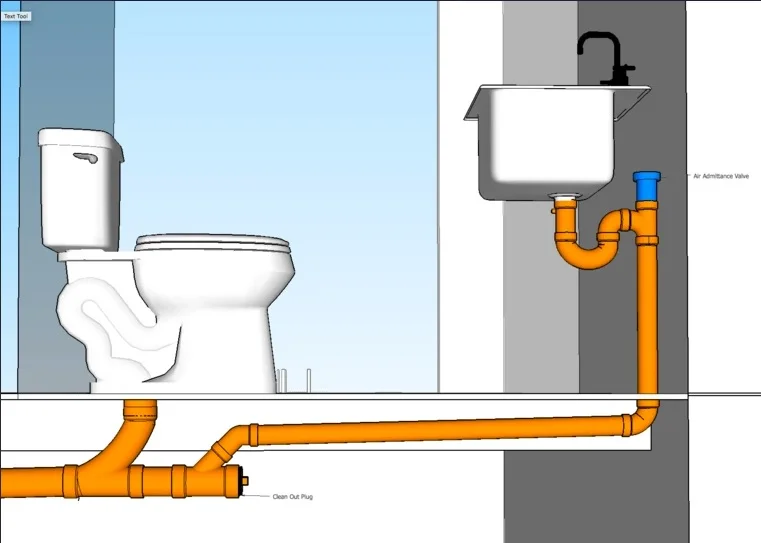Understanding Rough-In Plumbing
Rough-in plumbing is an essential phase in the construction or renovation of a building that involves the installation of plumbing pipes, fittings, and fixtures before the walls and floors are finished. This crucial step lays the groundwork for the entire plumbing system, ensuring proper functionality, efficiency, and safety once the project is completed. In this article, we’ll delve into the intricacies of rough-in plumbing, its key components, and its significance in the overall construction process.
The Basics of Rough-In Plumbing:

Rough-in plumbing refers to installing plumbing pipes and fittings at the initial stages of construction, typically before the walls are closed in with drywall or other finishing materials. During this phase, plumbers work closely with other tradespeople, such as framers, electricians, and HVAC technicians, to ensure all necessary infrastructure is in place before the building is enclosed.
Key Components of Rough-In Plumbing:
Several key components make up rough-in plumbing, including:
Supply Pipes:
These pipes deliver water to various fixtures throughout the building, such as sinks, toilets, showers, and bathtubs. Supply pipes are typically made of copper, PVC (polyvinyl chloride), PEX (cross-linked polyethene), or CPVC (chlorinated polyvinyl chloride).
Drainage Pipes:
Drainage pipes are responsible for removing wastewater from plumbing fixtures and carrying it away from the building. Common materials used for drainage pipes include PVC, ABS (acrylonitrile butadiene styrene), cast iron, and galvanised steel.
Vent Pipes:
Vent pipes allow air to enter the plumbing system, preventing the buildup of vacuum pressure and ensuring smooth drainage flow. Vent pipes are typically connected to drainage pipes and extend through the roof of the building to vent sewer gases safely outside.
Fixture Rough-Ins:
Fixture rough-ins refer to installing plumbing connections for specific fixtures, such as toilets, sinks, showers, and bathtubs. This includes positioning supply lines, drainage pipes, and vent pipes according to the manufacturer’s specifications and local building codes.
Importance of Proper Rough-In Plumbing:
Proper rough-in plumbing is essential for several reasons:
Ensuring Proper Functionality:
A well-planned and properly installed rough-in plumbing system ensures water flows smoothly to fixtures and wastewater is efficiently removed from the building. This prevents clogs, leaks, and backups that disrupt the plumbing system’s functionality.
Compliance with Building Codes:
Rough-in plumbing must comply with local building codes and regulations to ensure the safety and integrity of the plumbing system. Building codes dictate the minimum standards for pipe sizing, slope gradients, venting requirements, and fixture placements to prevent health hazards and structural damage.
Facilitating Future Upgrades and Repairs:
A well-executed rough-in plumbing job makes it easier to perform future upgrades or repairs to the plumbing system. Accessible pipe runs, properly positioned fixtures, and clearly labelled shut-off valves simplify maintenance tasks and minimise disruptions to occupants.
Optimising Energy Efficiency:
Properly designed rough-in plumbing systems can contribute to energy efficiency by minimising water waste and reducing the workload on water heaters and other appliances. This can result in lower utility bills and reduced environmental impact over the life of the building.
The Rough-In Plumbing Process:
The rough-in plumbing process typically follows these steps:
Blueprint Review:
Plumbers review the building plans and specifications to identify the locations of fixtures, supply lines, drainage paths, and venting requirements. They coordinate with other trades to ensure plumbing infrastructure integrates seamlessly with electrical, HVAC, and structural elements.
Pipe Installation:
Plumbers begin by installing supply, drainage, and vent pipes according to the approved plans and building codes. They carefully measure and cut pipes, secure them in place with hangers or straps, and connect them using appropriate fittings and joining methods.
Fixture Placement:
Plumbers position fixtures such as toilets, sinks, showers, and bathtubs in designated locations, ensuring proper alignment with supply and drainage connections. They verify clearances, rough-in dimensions, and accessibility for future maintenance.
Testing and Inspection:
Once the rough-in plumbing is complete, the system undergoes pressure testing to check for leaks and ensure proper function. Local building authorities inspect the plumbing work to verify compliance with codes and regulations before closing the walls.
Tips for Successful Rough-In Plumbing:
To ensure a successful rough-in plumbing installation, consider the following tips:
Plan Ahead:
Take the time to carefully plan the layout and design of the plumbing system, considering factors such as fixture placement, pipe routing, and accessibility for maintenance.
Use Quality Materials:
Invest in high-quality pipes, fittings, and fixtures that meet or exceed industry standards for durability, performance, and safety.
Follow Building Codes:
Adhere to local building codes and regulations governing plumbing installations to avoid costly rework and ensure compliance with legal requirements.
Work with Experienced Professionals:
Hire experienced plumbers knowledgeable about rough-in plumbing techniques and best practices. Communicate openly with your plumbing contractor and other trades to coordinate schedules and resolve any conflicts or issues during construction.
Perform Thorough Testing:
Conduct comprehensive pressure testing and inspections to identify and rectify any leaks, defects, or code violations before proceeding to the next construction phase.




